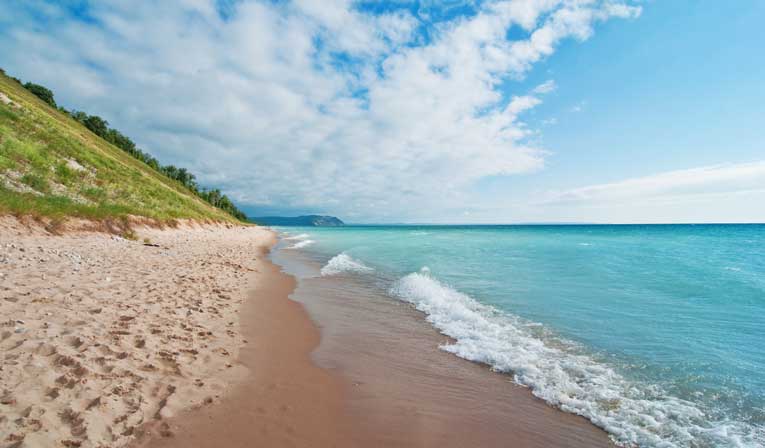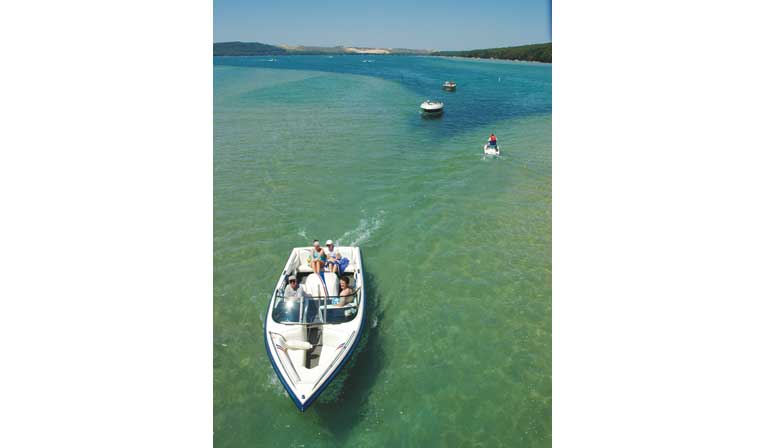Photo courtesy of Traverse City Convention & Visitors Bureau
Michigan’s Sleeping Bear Dunes is one of the most celebrated and picturesque locales in the U.S.
Unlike the craggy Wisconsin coast far to the west, Lake Michigan’s eastern shoreline is a long rim of golden sand — from broad beaches, to towering bluffs, to windswept dunes. They each offer their own magic, but one particular spot stands out. And it stands out so prominently, ABC’s “Good Morning America” news program proclaimed it “The Most Beautiful Place in America” in August 2011.
What Great Lakes destination could beat such internationally recognized hotspots as Newport, Rhode Island; Cape Cod, Massachusetts; Point Reyes National Seashore, California; Aspen, Colorado; Sedona, Arizona; Grand Teton National Park, Wyoming; and even Lanikai Beach, Hawaii?
Imagine 35 miles of pristine coastline, more than 70,000 acres of forested, glacially carved landscape, two offshore emerald islands, 26 inland lakes and jaw-dropping sand dunes. This is Sleeping Bear Dunes National Lakeshore, in northern Michigan’s Leelanau and Benzie counties. And there’s no place like it in the Great Lakes — or in America.
Sleeping Bears legend
Located at the base of Michigan’s celebrated Leelanau Peninsula and an easy 30-minute drive from Traverse City, Sleeping Bear Dunes National Lakeshore was established on October 21, 1971 by the National Park Service (NPS). Inspired by the national seashores at Cape Hatteras and Big Sur, NPS sought to protect outstanding natural areas on the U.S. “third coast.”
The park’s name comes from a somewhat heart-rending Ojibwe legend. As the story goes, a mother bear and her two cubs leaped into Lake Michigan to escape a raging forest fire on Lake Michigan’s western shore. Although they planned to swim across the lake, only the mother made it; her cubs became exhausted and drowned within sight of land. Ever hopeful, the mother bear found a tall bluff where she could sit and wait for their safe return.
The Ojibwe people said the Great Spirit created North and South Manitou islands as memorials to the lost cubs. Meanwhile, the relentless prevailing winds buried the mother bear in shifting dune sands atop her bluff. There she still lies sleeping, waiting for her babies to come home.
Today, Sleeping Bear Dunes National Lakeshore receives more than a million visitors each year. They come to hike, bike, backpack, camp, fish, paddle and simply drive along the park’s miles of spectacular country roads.
In fact, a car tour is perhaps the best way to get a feel for the many facets of this hidden Great Lakes gem. Start at the Philip A. Hart Visitor’s Center and park headquarters in Empire, where you can enjoy a variety of exhibits, a multimedia presentation and the bookstore, pick up park entrance passes, interpretive guides and other informational literature, and talk with a ranger.
From there, head north into the park’s middle unit and take the 7.4-mile Pierce Stocking Scenic Drive. Named for a Michigan lumberman who built the original road and operated it until his death in 1976 (it was incorporated into the park a year later), the scenic drive offers sublime views of inland Glen Lake — and of Lake Michigan, from an observation platform that soars 450 feet above lake level. The dunes here are mesmerizing, and compelling, but think twice before you head down. Not only are there safety concerns, but climbing has contributed to significant dune erosion.

Photo by Mark Bauhs
Photo by Mark Bauhs
Uphill climb
If you want to climb a dune, fear not. Simply head farther north to the aptly named Dune Climb on the west side of M-109, about 5 miles north of Empire. This is where you can race, gasping, to the top and then run or tumble back to the picnic area. If you aren’t keen to work quite that hard — or to bring more sand home in your clothes and shoes than you ever thought possible — the flat, 0.9-mile Duneside Interpretive Trail offers a more laid-back dune experience.
If you’re in good physical condition and have plenty of water, however, you might seek adventure beyond the Dune Climb. In that case, continue on to Lake Michigan from the summit. The hike is about 3.5 miles round-trip, and you’ll be climbing and descending several steep dunes. If you’re up for the exercise, it’s worth it; you might even see a ghost forest, buried and then exposed by the shifting dunes. Just remember to take only photographs, and leave only footprints.
Driving north on M-109 from the Dune Climb, you’ll reach the historic community of Glen Haven on Sleeping Bear Bay. Originally called Sleeping Bearville by founder Charles McCarty, Glen Haven was a company town from 1865 to 1931, supplying ships traveling up and down Lake Michigan. Here, you can see the town’s general store, blacksmith shop, canning company and 1865 Sleeping Bear Inn, which was expanded to better accommodate summer tourists in the 1920s.
Not far from Glen Haven is the Sleeping Bear Point Coast Guard Station Maritime Museum, where you can see exhibitions highlighting Great Lakes shipping history, the U.S. Coast Guard and the U.S. Life-Saving Service. In fact, the museum is the original life-saving station for Sleeping Bear Point; it was moved from its first location due to those encroaching, unpredictable dune sands.
While you’re there, don’t miss the Lyle Gun. This was used to fire a rescue line from shore to a ship in distress; it could travel more than 400 yards to retrieve crew. Another museum favorite is the second-story room outfitted as a steamer wheelhouse, which provides panoramic views of the Manitou Passage. During the heyday of Great Lakes shipping, hundreds of ships used this passage daily to avoid the perils of the open lake.
Farther north, at Port Oneida, is another historic district that was originally established to serve passing ships. Thomas Kelderhouse built a dock there, and in 1860 Port Oneida had a population of 87 people. Although the community was ultimately abandoned, visitors to the 3,000-acre district will see a rare collection of 16 historic farms. On the second Friday and Saturday in August, the Port Oneida Fair celebrates rural 19th and early 20th century farm life.

Photo Courtesy of Traverse City Convention & Visitors Bureau
Explore the area
As with many national parks throughout the country, the best way to truly experience Sleeping Bear Dunes is to get out of the car. Not only can you enjoy 100 miles of designated hiking trails, which feature evocative names such as Old Indian, Platte Plains, Empire Bluff, Windy Moraine, Shauger Hill, Cottonwood, The Dunes, Alligator Hill, Bay View, Pyramid Point and Good Harbor Bay, you may elect to strap on a backpack and revel in an authentic wilderness experience, spending the night at either the White Pine or Valley View backcountry camps.
White Pine is on the Platte Plains trail system, 2 miles from the trailhead. Valley View is near Glen Arbor, 1.5 miles from the trailhead. While the former is within walking distance of Lake Michigan, you’ll have to pack in your water at the latter.
If you would prefer more family-friendly “car camping,” you can choose between the Platte River Campground in the park’s southernmost unit or the D.H. Day Campground in the middle unit, near Glen Haven. Platte River features every variety of campsite, from RV sites with full electric hookups to walk-in tent sites, and restrooms with shower facilities are available. At D.H. Day, all sites are rustic.
Or you can combine your options, using one of the main campgrounds as a base and then heading into the backcountry for a night or two. Take the time to explore the Manitous; experienced backpackers insist that some of Michigan’s finest backcountry camping lies here. Manitou Island Transit in Leland ferries backpackers and day-trippers to the islands; on South Manitou, you can see the 1872 South Manitou Island Lighthouse, now a museum, and the 1858 life-saving station. The complex is listed on the National Register of Historic Places.
While cruising through Leland, don’t miss Leland Harbor. Recently dredged to a depth of a 13 feet, the facility’s boater services building, fully-renovated in 2009, is easily accessible. Here, boaters can make good use of 69 transient slips and 300 lineal feet of broadside. Enjoy ample shopping in historic Fishtown, where the marina is located. For more information, call 231-256-9132.
The national lakeshore has a third life-saving station, known as the North Manitou Coast Guard station. It dates to 1854, is a National Historic Landmark District and is listed on the National Register of Historic Places.
For certified scuba divers, these are surprisingly rich waters. The Manitou Passage Underwater Preserve is the final resting place for wrecks like the ocean-going freighter
Francisco Morazon and the wooden steamer Walter L. Frost, which both lie in shallow water off South Manitou Island; the three-masted schooner Alva Bradley, which sits at 20 to 27 feet between the islands; and the wooden steamer Three Brothers, an excellent novice site at 5 to 45 feet in the lee of South Manitou.
Additional novice sites lie near the mainland shore, off Sleeping Bear Point and Pyramid Point, and the historic towns of Empire and Glen Haven offer additional diving and snorkeling opportunities. Deeper wrecks, like the wooden steamer Congress at 135 feet, have their own unique thrills and challenges for more experienced divers.
Fun for all seasons
Water fun doesn’t begin and end with scuba diving, however. Bring along your canoe or kayak and enjoy some peaceful paddling on the inland lakes… or a more energetic expedition on the Platte River. Here, too, the whole family can enjoy tubing in the warm summer sun.
Or, head for the beach. Pristine Lake Michigan beaches are easily accessible at Platte River Point, Tiesma Road, Peterson Road, Esch Road, North Bar Lake, County Roads 669 and 651, the Sleeping Bear Point Maritime Museum and the Glen Haven Cannery. Don’t miss the ever-changing inlets at North Bar Lake and Otter Creek off Esch Road.
If you’re hoping for warmer, more sheltered waters, check out North Bar Lake and the Glen Lake picnic area near the Dune Climb.
Anglers in the group may want to try their hand at catching trout, pike, bass or salmon while visiting the park. Trailerboaters will find a boat launch off M-22 for Loon Lake; in the park’s northern unit, there’s another launch for School Lake on County Road 669. Canoes and kayaks can use a special launch at Otter Lake.
According to NPS, fishermen won’t want to miss Lake Manitou on Northern Manitou Island for smallmouth bass fishing. Just remember: This is an artificial-lure-only lake, with an 18-inch minimum for catches.
In case your northern Michigan trip won’t coincide with the height of summer, remember that Sleeping Bear Dunes National Lakeshore is more than a peak-season haven. In the fall, its forests are ablaze with autumn color, the midweek crowds have disappeared, and the crisp, clear weather is perfect for hiking, biking and fishing.
And for those who enjoy winter sports, Sleeping Bear Dunes is an undeniable offseason wonderland. Hiking trails transform into snowy highways for silent sports like cross-country skiing and snowshoeing, ice fishermen dot the lakes, and intrepid winter campers fill the Platte River Campground and White Pine backcountry sites. The Dune Climb continues to draw thrill-seekers, but in winter, they come armed with sleds.
If you haven’t had a chance to explore Sleeping Bear Dunes National Lakeshore, consider adding it to your Great Lakes bucket list, regardless of season. You’ll quickly discover that tens of thousands of “Good Morning America” voters weren’t wrong… this just might be the most beautiful place in America.




